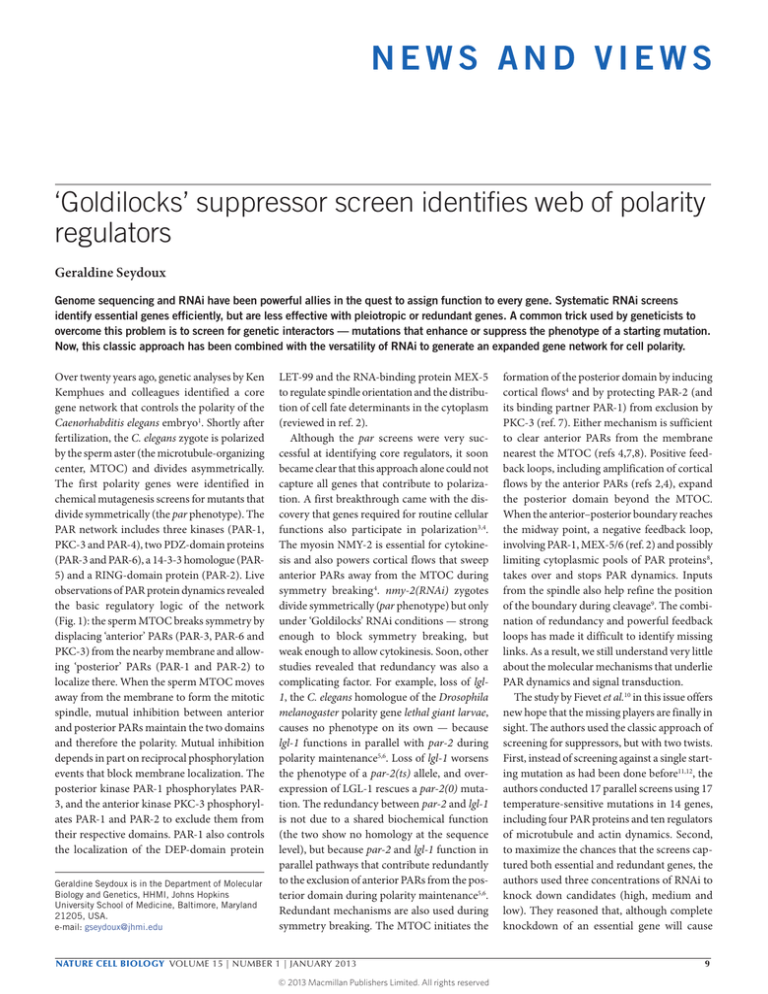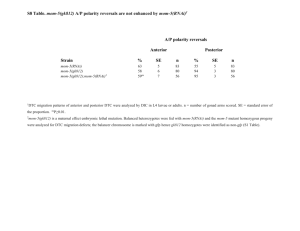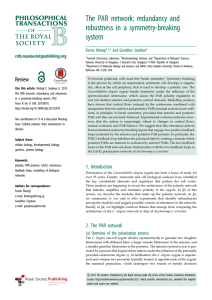N E W S A N D ... ‘Goldilocks’ suppressor screen identifies web of polarity regulators Geraldine Seydoux
advertisement

NEWS AND VIEWS ‘Goldilocks’ suppressor screen identifies web of polarity regulators Geraldine Seydoux Genome sequencing and RNAi have been powerful allies in the quest to assign function to every gene. Systematic RNAi screens identify essential genes efficiently, but are less effective with pleiotropic or redundant genes. A common trick used by geneticists to overcome this problem is to screen for genetic interactors — mutations that enhance or suppress the phenotype of a starting mutation. Now, this classic approach has been combined with the versatility of RNAi to generate an expanded gene network for cell polarity. Over twenty years ago, genetic analyses by Ken Kemphues and colleagues identified a core gene network that controls the polarity of the Caenorhabditis elegans embryo1. Shortly after fertilization, the C. elegans zygote is polarized by the sperm aster (the microtubule-organizing center, MTOC) and divides asymmetrically. The first polarity genes were identified in chemical mutagenesis screens for mutants that divide symmetrically (the par phenotype). The PAR network includes three kinases (PAR-1, PKC-3 and PAR-4), two PDZ-domain proteins (PAR-3 and PAR-6), a 14-3-3 homologue (PAR5) and a RING-domain protein (PAR-2). Live observations of PAR protein dynamics revealed the basic regulatory logic of the network (Fig. 1): the sperm MTOC breaks symmetry by displacing ‘anterior’ PARs (PAR-3, PAR-6 and PKC-3) from the nearby membrane and allowing ‘posterior’ PARs (PAR-1 and PAR-2) to localize there. When the sperm MTOC moves away from the membrane to form the mitotic spindle, mutual inhibition between anterior and posterior PARs maintain the two domains and therefore the polarity. Mutual inhibition depends in part on reciprocal phosphorylation events that block membrane localization. The posterior kinase PAR-1 phosphorylates PAR3, and the anterior kinase PKC-3 phosphorylates PAR-1 and PAR-2 to exclude them from their respective domains. PAR-1 also controls the localization of the DEP-domain protein Geraldine Seydoux is in the Department of Molecular Biology and Genetics, HHMI, Johns Hopkins University School of Medicine, Baltimore, Maryland 21205, USA. e-mail: gseydoux@jhmi.edu LET-99 and the RNA-binding protein MEX-5 to regulate spindle orientation and the distribution of cell fate determinants in the cytoplasm (reviewed in ref. 2). Although the par screens were very successful at identifying core regulators, it soon became clear that this approach alone could not capture all genes that contribute to polarization. A first breakthrough came with the discovery that genes required for routine cellular functions also participate in polarization3,4. The myosin NMY-2 is essential for cytokinesis and also powers cortical flows that sweep anterior PARs away from the MTOC during symmetry breaking 4. nmy-2(RNAi) zygotes divide symmetrically (par phenotype) but only under ‘Goldilocks’ RNAi conditions — strong enough to block symmetry breaking, but weak enough to allow cytokinesis. Soon, other studies revealed that redundancy was also a complicating factor. For example, loss of lgl1, the C. elegans homologue of the Drosophila melanogaster polarity gene lethal giant larvae, causes no phenotype on its own — because lgl-1 functions in parallel with par-2 during polarity maintenance5,6. Loss of lgl-1 worsens the phenotype of a par-2(ts) allele, and overexpression of LGL-1 rescues a par-2(0) mutation. The redundancy between par-2 and lgl-1 is not due to a shared biochemical function (the two show no homology at the sequence level), but because par-2 and lgl-1 function in parallel pathways that contribute redundantly to the exclusion of anterior PARs from the posterior domain during polarity maintenance5,6. Redundant mechanisms are also used during symmetry breaking. The MTOC initiates the NATURE CELL BIOLOGY VOLUME 15 | NUMBER 1 | JANUARY 2013 © 2013 Macmillan Publishers Limited. All rights reserved formation of the posterior domain by inducing cortical flows4 and by protecting PAR-2 (and its binding partner PAR-1) from exclusion by PKC-3 (ref. 7). Either mechanism is sufficient to clear anterior PARs from the membrane nearest the MTOC (refs 4,7,8). Positive feedback loops, including amplification of cortical flows by the anterior PARs (refs 2,4), expand the posterior domain beyond the MTOC. When the anterior–posterior boundary reaches the midway point, a negative feedback loop, involving PAR-1, MEX-5/6 (ref. 2) and possibly limiting cytoplasmic pools of PAR proteins8, takes over and stops PAR dynamics. Inputs from the spindle also help refine the position of the boundary during cleavage9. The combination of redundancy and powerful feedback loops has made it difficult to identify missing links. As a result, we still understand very little about the molecular mechanisms that underlie PAR dynamics and signal transduction. The study by Fievet et al.10 in this issue offers new hope that the missing players are finally in sight. The authors used the classic approach of screening for suppressors, but with two twists. First, instead of screening against a single starting mutation as had been done before11,12, the authors conducted 17 parallel screens using 17 temperature-sensitive mutations in 14 genes, including four PAR proteins and ten regulators of microtubule and actin dynamics. Second, to maximize the chances that the screens captured both essential and redundant genes, the authors used three concentrations of RNAi to knock down candidates (high, medium and low). They reasoned that, although complete knockdown of an essential gene will cause 9 NEWS AND VIEWS a Sperm MTOC aPARs pPARs Unknown cue Sperm pronucleus Microtubules MTOC-induced flows nop-1 PAR-2 loading Symmetry breaking b aPAR feedback loop nop-1 plst-1 Expansion and maintenance of PAR domains c A PKC-3 PAR-3 PAR-6 Phosphorylation Phosphorylation PAR-2 PAR-1 LGL-1 pPAR feedback loop MEX-5/6 and spindle feedback loops MEX-5/6 LET-99 Localization of cytoplasmic determinants Spindle positioning P Figure 1 Simplified model for polarization of the C. elegans zygote. (a) Before polarization, anterior PARs (aPARs, blue) at the membrane keep posterior PARs (pPARs, pink) in the cytoplasm. (b) The sperm MTOC breaks symmetry using two redundant cues (right): an unknown cue, which triggers cortical flows that mobilize anterior PARs; and microtubules, which protect PAR-2 from PKC-3, allowing PAR-2 (and its binding partner PAR-1) to load on the membrane. Because of the antagonism between aPARs and pPARs, either trigger is sufficient to break symmetry. (c) After symmetry breaking, aPAR and pPAR feedback loops amplify the effect of the MTOC, until the PAR-1–MEX-5/6 feedback loop stops domain expansion. A, anterior; P, posterior. Fievet et al.10 have added hundreds of genes to this core network, including the regulator of cortical contractility nop-1, which powers MTOC-induced cortical flows, and functions redundantly with the plastin homologue plst-1 to power aPAR-induced flows. lethality, partial knockdown might yield just the right level of gene activity to reveal a suppressive interaction. This Goldilocks approach was very effective: the authors estimate that over half of the 170 suppressors recovered would have been missed had they used only one RNAi condition. The screen reproduced several known interactions, including the mutual suppression between anterior and posterior PARs. For example, par-3, par-6 and pkc-3 were each isolated as RNAi suppressors of the par-2(ts) mutant. But most of the 227 interactions were unexpected and define potentially new functional groupings of polarity regulators. A key challenge in any suppressor screen is to weed out ‘informational’ suppressors that increase the expression or stability of the temperaturesensitive mutant protein, but do not participate directly in the process under study. The authors removed from the initial list dozens of genes with mitochondrial or ribosomal functions, as loss of these genes had been shown previously to suppress unrelated temperature-sensitive mutations13. Nevertheless, several candidates with known roles in gene regulation remained in the final list, including chromatin factors, 10 translation initiation factors, RNA-binding proteins and subunits of the multifunctional CCR4–NOT complex. An interesting possibility is that these interactions reflect a high dependence of the network on balanced anterior and posterior PAR protein levels, as has been suggested previously 8. To follow up on some of their candidates, the authors devised clever secondary screens based on known antagonisms in the network. For example, suppressors of nmy-2(ts) (which lowers actin contractility) were screened for enhancement of a gain-of-function act-2(ts) mutant (which increases actin contractility), and vice versa. These tests identified a group of 25 actomyosin ‘suppressor/enhancer’ genes, including 17 genes not previously implicated in cortical dynamics. Follow-up phenotypic characterizations of 9 of these genes confirmed that 8 regulate myosin localization, contractility and/or flow range. The screen also identified nop-1, a myosin regulator essential for MTOCinduced cortical flows during symmetry breaking 14,15. Screening for nop-1 enhancers among act-2(ts) suppressors identified the plastin (an actin-bundling protein) homologue plst-1, which functions primarily after symmetry breaking to expand PAR domains. The partial redundancy between nop-1 and plst-1 confirms that MTOC-induced and PAR-induced cortical dynamics are mechanistically distinct and function redundantly to mobilize anterior PARs (refs 4,14). Interestingly, nop-1 clusters with microtubule regulators in the network. During cytokinesis, nop-1 is required for furrow induction by astral microtubules14. An intriguing possibility is that the same nop-1/ aster-dependent mechanism drives cortical flows during symmetry breaking and PAR boundary refinement during cleavage14. The Goldilocks suppressor network adds 160 genes to the 37 genes previously implicated in polarization of the zygote. This collection is sure to become a gold mine for polarity enthusiasts. Many unexpected genes have turned up, and 80% of the suppressors have human homologues. Does this collection represent a complete list of all genes involved in zygote polarity? Unfortunately, that is unlikely. Because the Goldilocks approach requires three times as many RNAi treatments, the authors screened only 15% of the genome, concentrating their efforts on genes previously implicated in germline or embryo development. Missing from the list are many non-essential genes, including lgl-1 and several others isolated recently in a genome-wide screen for par-1 and par-4 enhancers15. Also, by relying on RNAi instead of chemical mutagenesis, the screen could not recover rare, allele-specific suppressor mutations in direct interactors. If whole-genome sequencing techniques continue to speed up the identification of ethyl methanesulphonate (EMS)-induced mutations16, it may one day become practical to use EMS mutagenesis to construct large suppressor networks. What is certain is that, even in the post-genomic era, suppressor genetics are here to stay. COMPETING FINANCIAL INTERESTS The author declares no competing financial interests. 1. Kemphues, K. J. et al. Cell 52, 311–320 (1988). 2. Noatynska, A. et al. Essays Biochem. 53, 1–14 (2012). 3. Guo, S. et al. Nature 382, 455–458 (1996). 4. Munro, E. et al. Dev. Cell 7, 413–424 (2004). 5. Beatty, A. et al. Development 137, 3995–4004 (2010). 6. Hoege, C. et al. Curr. Biol. 20, 1296–1303 (2010). 7. Motegi, F. et al. Nat. Cell Biol. 13, 1361–1367 (2011). 8. Goehring, N. W. et al. Science 334, 1137–1141 (2011). 9. Schenk, C. et al. Development 137, 1743–1753 (2010). 10.Fievet, B. T. et al. Nat. Cell Biol. 15, 103–112 (2013). 11.Labbe, J. C. et al. Genetics 174, 285–295 (2006). 12.Spilker, A. C. et al. Genetics 183, 965–977 (2009). 13.O’Rourke, S. M. et al. PLoS Genet. 3, e128 (2007). 14.Tse, Y. C. et al. Mol. Biol. Cell 23, 4020–4031 (2012). 15.Morton, D. G. et al. Genetics 192, 929–942 (2012). 16.Doitsidou, M. et al. PLoS ONE 5, e15435 (2010). NATURE CELL BIOLOGY VOLUME 15 | NUMBER 1 | JANUARY 2013 © 2013 Macmillan Publishers Limited. All rights reserved








